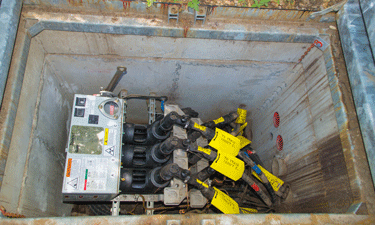 Maintaining the electrical distribution system across one of America’s largest protected landscapes is no picnic. Heavily forested, this area — an outdoor tourist destination roughly the size of Rhode Island — is unforgiving for workers tasked with maintaining the many electrical switchboxes, lines, vaults and poles that traverse the area. There are no direct routes to many of the sites where the electrical equipment is located, and limited cellphone reception complicates normal processes.
Maintaining the electrical distribution system across one of America’s largest protected landscapes is no picnic. Heavily forested, this area — an outdoor tourist destination roughly the size of Rhode Island — is unforgiving for workers tasked with maintaining the many electrical switchboxes, lines, vaults and poles that traverse the area. There are no direct routes to many of the sites where the electrical equipment is located, and limited cellphone reception complicates normal processes.
Frequently for outdoor attractions of this size, an electric utility supplies power to the property, typically at a single entry point. After that point, the medium-voltage (5kV-35kV) electrical system belongs to the facility it powers. When a tree limb takes out a power line on the property, or when electrical work is being done on a building complex, the agency’s own workers must reconfigure the power to that section of the electrical network.
Depending on the environment, the medium-voltage electrical equipment may be located at substations, on poles, in ground-level metal enclosures, or in underground vaults accessible via covers.
Switching medium voltage is more difficult than operating a light switch, but the concept is the same. The switchgear is specifically designed to handle the electrical arcs that are created when the switch is operated and to keep workers safe. In order to manage the arc, medium-voltage switchgear uses some form of insulation, such as air, oil, SF6 gas or a vacuum bottle with solid epoxy insulation.
In a natural area, electrical lines often run underground rather than on poles. There are two reasons for this: Underground lines don’t disturb the scenic beauty, and they are not vulnerable to falling tree limbs or other debris that cause outages during storms. To preserve the aesthetics, it is convenient to locate the switchgear underground with the electrical lines. When switchgear is installed underground, it must have a compact design and be immune to flooding.
In the case of the aforementioned outdoor attraction, the onsite electrical distribution system included 50 oil-insulated switches. Because of their age and the possibility of leaks, every one of them was supposed to be inspected and receive maintenance on a regular schedule, even though many are in difficult-to-reach areas. In addition, the possibility of the oil leaking in a sensitive area raised environmental concerns.
Given the situation, it’s no surprise that caretakers looked for new switchgear technology that might minimize the need for maintenance, decrease impacts to the environment and reduce the time needed to isolate faults and restore power.
Management recognized that one way to improve the situation would be to replace the oil switches with solid-dielectric vacuum interrupter switches that do not require maintenance and have no oil to leak or catch fire. After a near-miss safety incident, the facility’s maintenance department applied for a grant and received funds to help expedite the replacement of the old electrical equipment.
New Switches Require No Maintenance
Crews have begun to replace the old equipment with G&W Electric’s Trident with SafeVu solid dielectric switches. The switch offers an oil-free design in which the contacts open inside a vacuum bottle protected by solid epoxy insulation. Because the vacuum bottle contacts are not visible to the operator, a disconnect switch is placed in series with the vacuum bottle and provides an integrated visible break.
The successful installations have shown the new units to have several advantages. Aside from not requiring regular maintenance, they are safer for the crews. The internal visible break feature makes it possible to see clearly when the contact points are open. There is no need to pull an elbow or use externally mounted linkage systems to provide a visible open. And they’re fully resettable — no more fuses to stock or replace.
Another advantage is that the SafeVu solid dielectric switches are microprocessor-controlled. This means that the time/current trip curves and other protective parameters of each switch can be customized to meet the needs of each specific installation site while maintaining a single design for ease in purchasing and operations. When a switch trips open due to a faulted condition, the control records the fault current and cause of the trip. This allows crewmembers to more quickly find, isolate and repair the outage.
Crew Reaction
The SafeVu switches are reportedly a big hit with maintenance crews and their managers, who love the integrated visible break feature, as well as the additional safety they provide. They also appreciate the environmental friendliness of the solid dielectric design and the fact that the new switches are submersible, so heavy rains or local flooding during the spring snow melt causes no problems. But perhaps most of all, they like that the new oil-free switchgear does not require time-consuming periodic maintenance. Now the small crew can more easily manage its workload, without the need to add personnel.
Future Plans
The new switches also offer the ability for remote operation of the electrical system. This means that switches could be monitored and operated from the main office via a wireless communication system. This would provide time-saving information to the managers and crew by informing them not only of the location of any issues, but also the exact nature of any outages. A manager would have the ability to reroute power remotely around the outage rather than roll a service truck to manually operate the switches. This would return power to most of the property in the shortest amount of time and the crew could be dispatched directly to the outage site for repairs.
Karla Trost is the Senior Global Product Manager for G&W Electric.

